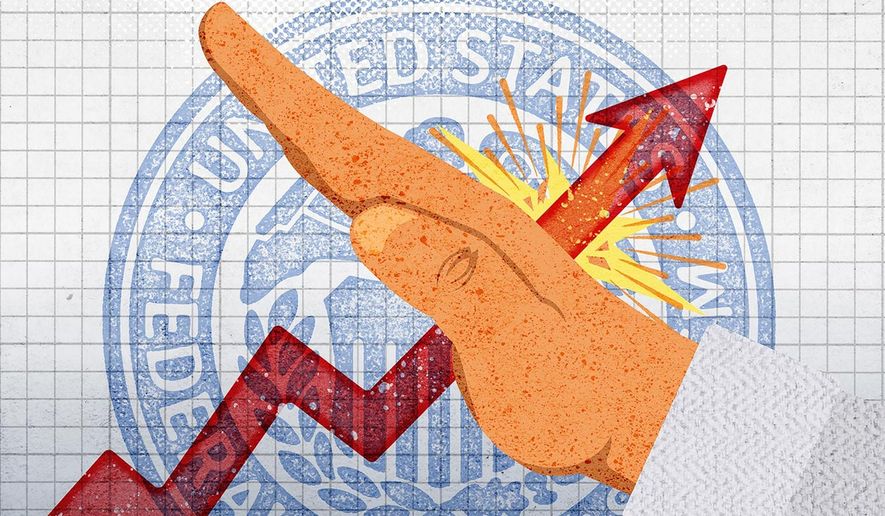OPINION:
Curing inflation with a get-tough monetary policy alone is like trying to fix an antique Swiss watch with one hand.
High inflation comes from demand pressures. Too much COVID-19 spending, and the Federal Reserve printing money to finance resulting federal deficits.
And supply pressures. Disruptions to food and energy supplies caused by the unaddressed fallout from climate change on global agriculture, President Vladimir Putin’s Black Sea blockade against Ukrainian exports, Western sanctions that curtail Russian petroleum exports, interruptions in global chip production and severe disruptions to global shipping and manufacturing that linger from COVID-19.
Pandemic relief sent money to folks who needed help but many that didn’t. Consequently, households have more than $3 trillion in savings and checking accounts than prior to the pandemic.
The Fed is running down its bond holdings by $47.5 billion monthly and $90 billion starting in September.
At that pace, it will take a painfully long time to remove all the excess liquidity from the economy. Normally, more expensive loans would trim car sales and inspire automakers to offer big discounts. But with chip shortages continuing and auto production curtailed, new vehicles are terribly scarce and sales are already depressed.
Housing shortages were acute before the Fed started pushing up mortgage rates. Now folks that can’t afford those are moving into rental units whose prices are terribly high. Although rising mortgage rates will limit the demand for new homes, fewer will be built and shortages will persist. Expensive rentals will enable builders and owners of existing homes to keep raising asking prices.
The cost of shelter is about one-third of the Consumer Price Index and with inflation running above 8%, higher mortgage rates won’t break those demand and supply dynamics until those reach about 10%.
Domestic drilling is curtailed by Biden administration leasing policies, higher federal royalty rates and subjecting refineries to tougher ethanol regulations. And fears in the industry of a Biden administration hell bent on scapegoating and shutting it down before adequate numbers of electric cars are on the road.
Vehicle manufactures won’t be offering mostly EVs until the early 2030s, and the average life of a new car is 12 years. Consequently, the majority of vehicles on the road will be petroleum fueled until the late 2030s. Longer if the auto industry can’t find enough lithium — that’s proving a challenge.
Russia produced about 10 million barrels a day of petroleum in 2021. If Western sanctions cut sales and production by 30%, with the rest going at a discount to China, India and other developing nations, that would come to about 3% of global demand and drive up prices about 30%.
That’s enough to cause considerable pain for American drivers but still maintain Russia’s revenues.
Similar logic applies to Russian and Ukrainian grain, sunflower oil and fertilizer production — for example, two countries account for 30% of the global wheat trade. Consequently, the U.S. strategy of slowly squeezing Russia through sanctions and Russia’s Black Sea blockade are creating global food shortages.
Petroleum is a critical component in agriculture. It’s used to make fertilizer and process fresh produce like canned tomatoes. Gasoline and diesel are needed to run farm equipment and move commodities. Rising fertilizer prices will lower, for example, rice harvests in Asia, contributing to an energy-fertilizer-food scarcity price cycle.
Biden policies curtailing petroleum field activity limits U.S. LNG available for export to Europe as it replaces Russian gas. That will raise U.S. heating bills this winter and the cost of most everything Americans import from Europe.
The Netherlands is shutting the Groningen gas field — the largest in Europe. As the Europeans completely phase out Russian gas, American consumers will feel that pain too.
Unless the Biden administration and European leaders recognize that wartime, all-out energy production policies are needed and take a more assertive posture toward the Russian invasion — for example, providing the Ukrainian military with offensive weapons and intelligence to strike inside Russia and breaking the Russian blockade with naval escorts for Ukrainian grain, sunflower and other food shipments — the Fed’s efforts to get inflation down to 2% is a fool’s journey.
Together, shelter, energy, food and new vehicles compose 58% of the CPI.
The Fed might get inflation down to 2% by screwing down price increases to zero in the other 42% of the economy, but the federal funds rate high enough to accomplish that would surely throw the economy into a deep and protracted recession
The Fed projects it will raise rates to a maximum of about 3.8% by 2023 and inflation will be at 2.2% by 2024. That’s not credible.
Chair Jerome Powell might do better trying to sell a certain roadway over the East River to Mayor Eric Adams. But judging by his energy and Ukrainian war policies, Mr. Powell could sell Mr. Biden the Brooklyn Bridge.
• Peter Morici is an economist, emeritus business professor at the University of Maryland, and national columnist.




Please read our comment policy before commenting.